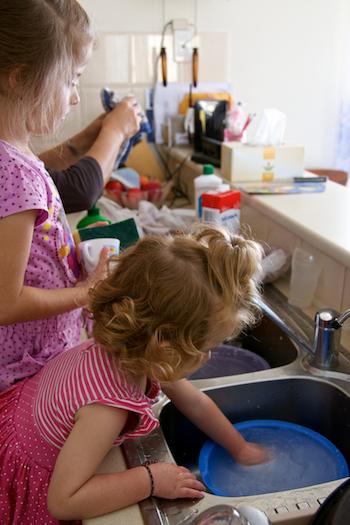Washing the dishes
Duration/age

Do you wash the dishes in a sink or in the dishwasher? Are there times when you choose to wash the dishes rather than put them in the dishwasher?
We need to wash the saucepans as they are too big to fit in the dishwasher.
If you don’t have a dishwasher do you wash up after every meal or wait until the end of the day when there is a pile of dishes to do?
There are only 2 plates and 2 glasses from our lunch so let’s wait and wash them with the dishes from dinner.
Ask your child to help you do the dishes. Explore how much water goes in the sink. Will there be one, two or lots of squirts of dishwashing liquid? Who will wash and who will dry?
Is there an order to how you do the dishes? Share it with your child so they can help to sort and categorise the dishes into the different groups.
Let’s wash all of the cups first and then the plates, so we can rest the plates against the cups to dry.
Talk to your child about the routine you have for drying the dishes. Do you dry them straightaway or leave them? If you like to dry the dishes straightaway explain to your child what will happen next.
Let’s make a pile of big plates and small plates and put all of them away after we have finished.
Materials you will need
- Water
- Dishes
- Dishwashing liquid
- Tea towel
Skills this activity improves
Why does this matter?
When children help with the dishes they are exploring spatial awareness, shape and are learning to sort and group by size and function.
As they help to dry the dishes they are developing fine motor skills in their hands. When they grasp a dish they are developing strength in their fingers and wrist. As they twist the dish around and move the tea towel across the surface of the dish they are developing strength and rotation in their wrists.
What does this lead to?
The development of fine motor skills and strength in children’s hands helps to develop their ability to write, draw and hold a pen correctly. When children develop strength and control in their hands they are able to write and draw for longer periods of time as their hands do not become tired. The strength in a child’s hands and fingers helps them to produce drawings with fine detail and small closed shapes.
By helping with the dishes children are developing awareness of movement and the relationship of their body to other objects. As they help with the dishes they are exploring how to make judgements related to distance and size.
Language to use
- Plate, spoon, bowl, cup, glass, cutlery, saucepan, frying pan
- Sink, dishwasher, dishwashing liquid, tea towel, sponge
- Wash, dry
- Pile, stack, lean, place, against, behind, upside down
Questions to use
- Where do the plates go?
- Which plate is bigger?
- How many dishes do we have to wash?
- Will you wash or will I?
- Are there more cups or bowls?
Useful tips
- Younger children love to help and play with water. They can help if you put a smaller bowl of water on a low table and let them the wash the plastic cups or plates.
- You might also like to take a look at the Loading the dishwasher activity.
- Remember to talk to your child in your home language.
More ideas
- Ask your child to help sort the dishes into different categories, such as cups, bowls and plates.
- Let your child help you by carrying the dishes to the sink.
Variation by age
Three to five year olds
- Ask your child to help you set the table.
- Ask your child to help you put away the dishes after they are done.
- Make a picnic basket for playing with outside.
Questions to ask
- Where do the plates go?
- Can you find all of the things we drink with?
- Do we have more large plates or small ones?
- Which plate should we dry first?
Language to use
- Table, sink
- Large, small
- Wet, dry
- First, next, last, finished


